Haryana State Board HBSE 9th Class Maths Important Questions Chapter 1 Number Systems Important Questions and Answers.
Haryana Board 9th Class Maths Important Questions Chapter 1 Number Systems
Very Short Answer Type Questions
Question 1.
Convert the following decimal number in the form
(i) 0.24
(ii) 8.03
(iii) 6.025
(iv) 0.4640.
Solution :
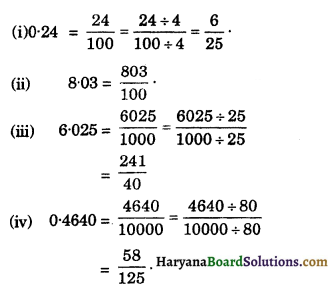
Question 2.
Give an example of each, two irrational numbers whose :
(i) difference is an irrational number.
(ii) sum is an irrational number.
(iii) product is an irrational number.
(iv) quotient is an irrational number
Solution:
(i) Let 5\(\sqrt{3}\) and 3\(\sqrt{3}\) be two irrational numbers.
∴ Difference = 5\(\sqrt{3}\) – 3\(\sqrt{3}\) = 2\(\sqrt{3}\),
which is an irrational number.
Hence, two irrational numbers are 5\(\sqrt{3}\) and 3\(\sqrt{3}\).
(ii) Let \(\sqrt{2}\) and \(\sqrt{3}\) be two irrational numbers.
∴ Sum = \(\sqrt{2}\) + \(\sqrt{3}\), which is an irrational number.
Hence, two irrational numbers are \(\sqrt{2}\) and \(\sqrt{3}\)
(iii) Let \(\sqrt{2}\) and \(\sqrt{5}\) be two irrational numbers.
∴ Their product = \(\sqrt{2}\) × \(\sqrt{5}\) = \(\sqrt{10}\).
which is an irrational number. Hence, two irrational numbers are \(\sqrt{2}\) and \(\sqrt{5}\).
(iv) Let \(\sqrt{6}\) and \(\sqrt{2}\) be two irrational numbers.
Their quotient \(\frac{\sqrt{6}}{\sqrt{2}}=\sqrt{\frac{6}{2}}=\sqrt{3}\), which is an irrational number. Hence, two irrational numbers are \(\sqrt{6}\) and \(\sqrt{2}\).
![]()
Question 3.
Find a rational and irrational number between two positive numbers x and y.
Solution:
A rational number between x and y = \(\frac{x+y}{2}\)
Since, product of x and y i.e., xy cannot be a perfect square.
Therefore, an irrational number between x and y = \(\sqrt{xy}\)
Hence, a rational number between x and y = \(\frac{x+y}{2}\) and an irrational number between x and y = \(\sqrt{xy}\).
Question 4.
Prove that 3 + \(\sqrt{5}\) is an irrational number.
Solution :
Let 3 + \(\sqrt{5}\) be a rational number, say x, then
3 + \(\sqrt{5}\) = x
⇒ x – 3 = \(\sqrt{5}\)
x – 3 is a rational number. [∵ difference of two ratinoal numbers is a rational number]
⇒ \(\sqrt{5}\) is a rational number.
But \(\sqrt{5}\) is an irrational number. So, our assumption is wrong.
Hence, 3 + \(\sqrt{5}\) is an irrational number.
Hence Proved
Question 5.
Add each of the following:
(i) (5\(\sqrt{3}\) – 7\(\sqrt{2}\)) and (2\(\sqrt{3}\) + 4\(\sqrt{2}\))
(ii) (6\(\sqrt{3}\) + 5\(\sqrt{5}\) – 4\(\sqrt{7}\)) and (\(\sqrt{3}\) – 4\(\sqrt{5}\) + 3\(\sqrt{7}\))
Solution:
(i) We have, (5\(\sqrt{3}\) – 7\(\sqrt{2}\)) + (2\(\sqrt{3}\) + 4\(\sqrt{2}\))
= 5\(\sqrt{3}\) – 7\(\sqrt{3}\) + 2\(\sqrt{3}\) + 4\(\sqrt{3}\)
= (5\(\sqrt{3}\) + 2\(\sqrt{3}\)) + (- 7\(\sqrt{2}\) + 4\(\sqrt{2}\))
= 7\(\sqrt{3}\) – 3\(\sqrt{2}\).
(ii) We have,
(6\(\sqrt{3}\) + 5\(\sqrt{5}\) – 4\(\sqrt{7}\)) + (\(\sqrt{3}\) – 4\(\sqrt{5}\) + 3\(\sqrt{7}\))
= 6\(\sqrt{3}\) + 5\(\sqrt{5}\) – 4\(\sqrt{7}\) + \(\sqrt{3}\) – 4\(\sqrt{5}\) + 3\(\sqrt{7}\)
= (6\(\sqrt{3}\) + \(\sqrt{3}\)) + (5\(\sqrt{5}\) – 4\(\sqrt{5}\)) + (- 4\(\sqrt{7}\) + 3\(\sqrt{7}\))
= 7\(\sqrt{3}\) + \(\sqrt{5}\) – \(\sqrt{7}\).
Question 6.
Multiply each of the following :
(i) 3\(\sqrt{2}\) by 5\(\sqrt{3}\)
(ii) 6\(\sqrt{5}\) by 2\(\sqrt{7}\)
(iii) \(\sqrt{10}\) by \(\sqrt{30}\)
Solution :
We have,
(i) 3\(\sqrt{2}\) × 5\(\sqrt{3}\) = 3 × 5 × \(\sqrt{2}\) × \(\sqrt{3}\) = 15\(\sqrt{6}\).
(ii) 6\(\sqrt{5}\) × 2\(\sqrt{7}\) = 6 × 2 × \(\sqrt{5}\) × \(\sqrt{7}\)
= 12\(\sqrt{35}\).
(iii) \(\sqrt{10}\) × \(\sqrt{30}\)
= \(\sqrt{10 \times 30}\)
= \(\sqrt{10 \times 10 \times 3}\)
= 10\(\sqrt{3}\).
![]()
Question 7.
Simplify each of the following expressions:
(i) (5 + \(\sqrt{5}\))(2 + \(\sqrt{3}\))
(ii) (\(\sqrt{5}\) – \(\sqrt{3}\)) (\(\sqrt{5}\) + \(\sqrt{3}\))
(iii) 3\(\sqrt{3}\) + 2\(\sqrt{27}\) + \(\frac{7}{\sqrt{3}}\)
[NCERT Exemplar Problems]
Solution :
(i) We have (5 + \(\sqrt{5}\))(2 + \(\sqrt{3}\)) = 10 + 5\(\sqrt{3}\) + 2\(\sqrt{5}\) + \(\sqrt{15}\).
(ii) (\(\sqrt{5}\) – \(\sqrt{3}\)) (\(\sqrt{5}\) + \(\sqrt{3}\)) = (\(\sqrt{5}\))2 – (\(\sqrt{3}\))2
= 5 – 3 = 2.
(iii) 3\(\sqrt{3}\) + 2\(\sqrt{27}\) + \(\frac{7}{\sqrt{3}}\)
= 3\(\sqrt{3}\) + 2 × 3\(\sqrt{3}\) + \(\frac{7 \times \sqrt{3}}{\sqrt{3} \times \sqrt{3}}\)
= 3\(\sqrt{3}\) + 6\(\sqrt{3}\) + \(\frac{7 \sqrt{3}}{3}\) = 9\(\sqrt{3}\) + \(\frac{7 \sqrt{3}}{3}\)
= \(\frac{27 \sqrt{3}+7 \sqrt{3}}{3}=\frac{34 \sqrt{3}}{3}\)
Question 8.
Evaluate :
(i) (64)– 1/2
(ii) (32)3/5.
Solution:
We have
(i) (64)– 1/2 = (82)– 1/2
= 82 × (- 1/2) = 8– 1 = \(\frac {1}{8}\)
(ii) (32)3/5 = (25)3/5
= 25 × 3/5 = 23 = 8.
Question 9.
Simplify:

[NCERT Exemplar Problems]
Solution:
We have
(i) 32/3. 31/5
= 32/3+1/5 =
= 3(10 + 3)/15
= 313/15
(ii) We have,
(\(\frac{1}{4^3}\))-2/3
= (43)2/3 = 43 × 2/3 = 42 = 16.
(iii) We have,
\(\frac{10^{1 / 3}}{10^{1 / 5}}\) = 101/3 – 1/5 = 10(5-3)/15 = 102/15
(iv) We have,
\(\left(-\frac{1}{64}\right)^{-2 / 3}\)
= (-64)2/3 = [(-4)3]2/3
= (- 4)3 × 2/3 = (-4)2 = 16.
(v) We have,
\(\frac{1}{3^{-2}} \cdot \frac{1}{5^{-2}}\) = 32 . 52 = (3 × 5)2
= 152 = 225.
![]()
Question 10.
Find the value of xx, if it is given that 2x – 2x – 1 = 4.
Solution:
We have,
2x – 2x-1 = 4
⇒ 2x – 2x.2-1 = 4
⇒ 2x (1 – 2-1) = 4
⇒ 2x(1 – \(\frac {1}{2}\)) = 4
⇒ 2x × \(\frac {1}{2}\) = 4
⇒ 2x = 8
⇒ 2x = 23
⇒ x = 3 [∵ bases are equal, ∴ exponents are equal]
∴ xx = 33
Hence, xx = 27.
Question 11.
If a =(l – m), b = (m – n) and c =(n – l), then prove that (xa)n . (xb)l . (xc)m = 0.
Solution :
We have, a = (l – m), b = (m – n) and c = (n – l)
L.H.S. = (xa)n . (xb)l . (xc)m
= (xl – m)n . (xm – n)l . (xn – l)m
= x(ln – mn) . x(ml – nl) . x(mn – ml)
= xln – mn + ml – nl + mn – ml
= x0 = 1 = R.H.S.
∴ L.H.S. = R.H.S. Hence proved
Question 12.
Prove that:
\(\left(\frac{x^a}{x^b}\right)^{(a+b)} \times\left(\frac{x^b}{x^c}\right)^{(b+c)} \times\left(\frac{x^c}{x^a}\right)^{(c+a)}\) = 1
Solution :

Short Answer Type Questions
Question 1.
Represent \(\frac {4}{3}\) and –\(\frac {4}{3}\) on the number line.
Solution:
For representing \(\frac {4}{3}\) and –\(\frac {4}{3}\) on the number line, we draw a number line and mark a point O on it to represent zero. Now we find the points A, B, C on the number line representing the positive integers 1, 2, 3 and the points P, Q, R on the number line representing negative integers – 1, – 2, – 3 respectively as shown in figure 1.3.

\(\frac {4}{3}\) lies between the positive integers 1 and 2. Similarly –\(\frac {4}{3}\) lies between the negative integers – 1 and – 2. So, we divide the AB and PQ in three equal parts such that AM = MN = NB and PX = XY = YQ. So the points M and X represents \(\frac {4}{3}\) and –\(\frac {4}{3}\) respectively on the number line.
![]()
Question 2.
Find five rational numbers between \(\frac {3}{5}\) and \(\frac {3}{4}\).
Solution :
Let a = \(\frac {3}{5}\) and b = \(\frac {3}{4}\) and
n = 5
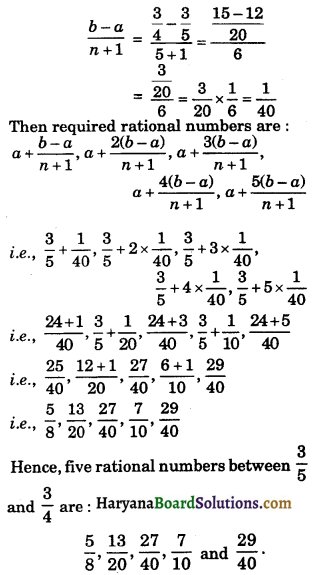
Question 3.
Express the following in the form where p and q are integers and
(i) \(5 \cdot \overline{2}\)
(ii) \(12 \cdot \overline{48}\)
[NCERT Exemplar Problems]
Solution:
(i) Let
x = \(5 \cdot \overline{2}\) = 5.2222 ……..(i)
Multiplying equation (i) by 10, we get
10x = \(52 \cdot \overline{2}\) ……..(ii)
Subtracting the equation (i) from (ii), we get
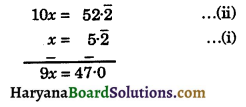
⇒ x = \(\frac {47}{9}\)
Hence, \(5 \cdot \overline{2}\) = \(\frac {47}{9}\)
(ii) Let x = \(12 \cdot \overline{48}\) = 12.484848 ……… (i)
Multiplying equation (i) by 100, we get
100x = \(1248 \cdot \overline{48}\) ……… (ii)
Subtracting equation (i) from (ii), we get
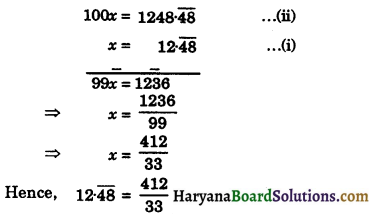
![]()
Question 4.
Write the following in decimal form and say what kind of decimal expansion each has: \(\frac {5}{13}\)
Solution:
(i) By long division, we have

Hence, \(\frac {5}{3}\) = 0.384615384615…. = \(0 \cdot \overline{384615}\)
It has non-terminating and repeating decimal expansion.
Question 5.
Express the rational number \(\frac {1}{13}\) in decimal form and hence find the decimal expansions of \(\frac {1}{13}\) , \(\frac {2}{13}\) and \(\frac {3}{13}\).
Solution :
By long division, we have
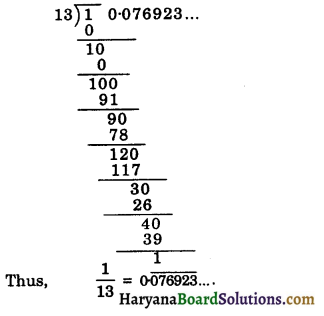
We observe that remainder repeat after six digit. So, it has repeating block of six digits. The given rational numbers \(\frac {2}{13}\), \(\frac {3}{13}\) and \(\frac {4}{13}\) will also have repeating block of six digits in the decimal expansion.
So, to obtain the decimal expansion of given rational numbers mutliplying \(0 \cdot \overline{076923}\) successively by 2, 3 and 4 as follows :
\(\frac {2}{13}\) = 2 × \(\frac {1}{13}\) = 2 × \( \cdot \overline{76923}\) = \(0 \cdot \overline{153846}\)
\(\frac {3}{13}\) =3 × \(\frac {1}{13}\) = 3 × \(0 \cdot \overline{076923}\) = \(0 \cdot \overline{230769}\)
and \(\frac {4}{13}\) = 4 × \(\frac {1}{13}\) = 4 × \(0 \cdot \overline{076923}\) = \(0 \cdot \overline{307692}\)
Question 6.
Prove that 3\(\sqrt{2}\) is an irrational number.
Solution :
Let 3\(\sqrt{2}\) be a rational number, say x, then
3\(\sqrt{2}\) = x
⇒ \(\sqrt{2}\) = \(\frac {x}{3}\)
Since x is a rational number and 3 is nonzero rational number.
∴ \(\frac {x}{3}\) being the quotient of two rational numbers, is a rational number.
⇒ \(\sqrt{2}\) is a rational number.
But \(\sqrt{2}\) is an irrational number. So, our assumption is wrong.
Hence, 3\(\sqrt{2}\) is an irrational number.
Proved
![]()
Question 7.
Prove that \(\sqrt{3}\) – \(\sqrt{2}\) is not a rational number.
Solution :
Let \(\sqrt{3}\) – \(\sqrt{2}\) be a rational number, say x.
∴ \(\sqrt{3}\) – \(\sqrt{2}\) = x
Squaring both sides, we get
(\(\sqrt{3}\) – \(\sqrt{2}\))2 = x2
⇒ 3 + 2 – 2 × \(\sqrt{3}\) × \(\sqrt{2}\) = x2
⇒ 5 – 2\(\sqrt{6}\) = x2
⇒ 5 – x2 = 2\(\sqrt{6}\)
⇒ \(\frac{5-x^2}{2}\) = \(\sqrt{6}\)
∵ x is a rational number.
∴ \(\frac{5-x^2}{2}\), is a rational number.
⇒ \(\sqrt{6}\) is a rational number
But \(\sqrt{6}\) is an irrational number
So our assumption is wrong.
⇒ \(\sqrt{3}\) – \(\sqrt{2}\) is not a rational number.
Hence, \(\sqrt{3}\) – \(\sqrt{2}\) is not a rational number.
Proved
Question 8.
Represent \(\sqrt{5.6}\) geometrically on the number line. [NCERT Exemplar Problems]
Solution :
Draw a line AB of length 5.6 units, produce AB to a point C such that BC = 1 unit. Find the mid-point of AC and marked that point 0. Draw a semicircle with centre O and radius OA. Draw a line perpendicular to AC passing through Band intersecting the semicircle at D, then BD = \(\sqrt{5.6}\) units.
Now B as centre and BD as radius, draw an arc meeting AC produced at E, then BE = BD = \(\sqrt{5.6}\) units.

Question 9.
Simplify \(\frac{1}{\sqrt{6}+\sqrt{5}+\sqrt{11}}\)
Solution :
R.F. of the denominator
[(\(\sqrt{6}\) + \(\sqrt{5}\)) + \(\sqrt{11}\)] is [(\(\sqrt{6}\) + \(\sqrt{5}\)) – \(\sqrt{11}\)].
Therefore, multiplying numerator and denominator by [(\(\sqrt{6}\) + \(\sqrt{5}\)) – \(\sqrt{11}\)], we get
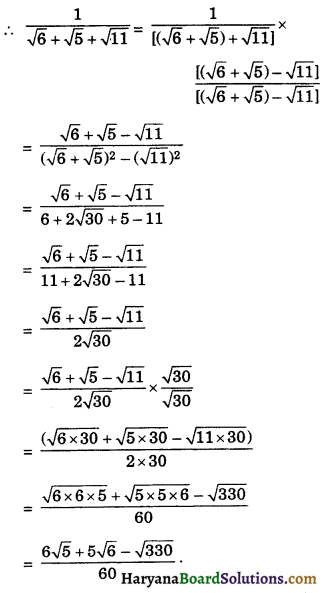
![]()
Question 10.
Simplify \(\frac{3 \sqrt{2}-2 \sqrt{3}}{3 \sqrt{2}+2 \sqrt{3}}+\frac{2 \sqrt{3}}{\sqrt{3}-\sqrt{2}}\) by rationalising the denominator.
Solution :
We have

Question 11.
It is given that \(\sqrt{2}\) = 1.414, \(\sqrt{3}\) = 1.732, \(\sqrt{5}\) = 2.236 and \(\sqrt{6}\) = 2.449. Find the value of each of the following upto three places of decimal :
(i) \(\frac{7}{\sqrt{10}}\)
(ii) \(\frac{\sqrt{6}+2 \sqrt{2}}{\sqrt{3}}\)
Solution:
We have
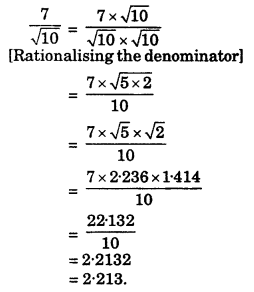
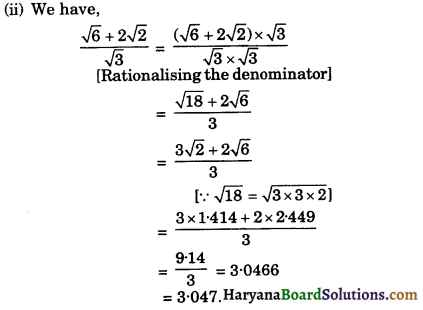
Question 12.
Prove that:
\(\frac{1}{3-\sqrt{8}}-\frac{1}{\sqrt{8}-\sqrt{7}}+\frac{1}{\sqrt{7}-\sqrt{6}}-\frac{1}{\sqrt{6}-\sqrt{5}}+\frac{1}{\sqrt{5}-2}\) = 5
Solution:
Rationalizing the denominator of each term, we get
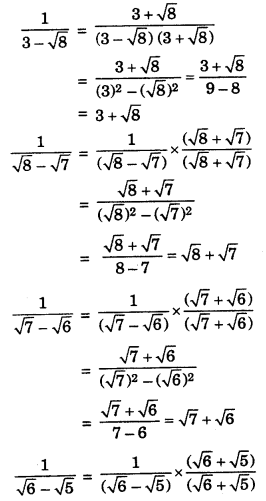
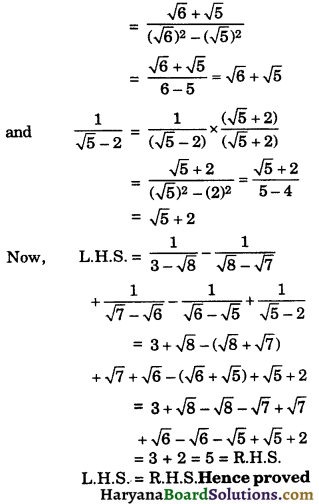
![]()
Question 13.
Simplify :
\(\frac{2^{1 / 2} \times 3^{1 / 3} \times 4^{1 / 4}}{10^{-1 / 5} \times 5^{3 / 5}} \div \frac{3^{4 / 3} \times 5^{-7 / 5}}{4^{-3 / 5} \times 6}\).
Solution:
We have
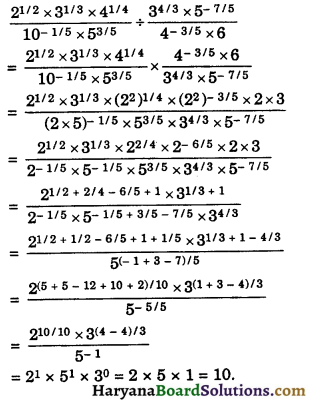
Question 14.
If x, y, z are positive real numbers, then prove that :
\(\sqrt{x y-1} \cdot \sqrt{y z-1} \cdot \sqrt{z x-1}\) = 1
Solution :
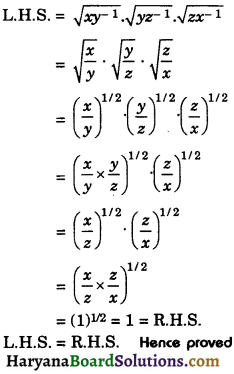
Question 15.
If 2x+4 – 2x+2 = 3, then find the value of x.
Solution :
We have
2x+4 – 2x+2 = 3
⇒ 2x+2+2 – 2x+2 = 3
⇒ 22 . 2x+2 – 2x+2 = 3
⇒ 2x+2(22 – 1) = 3
⇒ 2x+2(4 – 1) = 3
⇒ 2x+2 × 3 = 3
⇒ 2x+2 = \(\frac {3}{3}\)
⇒ 2x+2 = 1
⇒ 2x+2 = 20
⇒ x + 2 = 0
[if bases are equal, then exponents are also equal]
Hence x = – 2
![]()
Question 16.
If 3x = 5y = (75)z, show that z = \(\frac{x y}{2 x+y}\).
Solution :
Let 3x = 5y = (75)z = k
Then, 3x = k
⇒ 3 = k1/x …..(i)
5y = k
⇒ 5 = k1/y …..(ii)
and (75)z = k
⇒ 75 = k1/z
⇒ 3 × 52 = k1/z
⇒ k1/x × k2/y = k1/z [From (i) and (ii)]
⇒ k1/x+2/y = k1/z
⇒ \(\frac{1}{x}+\frac{2}{y}=\frac{1}{z}\) [On comparing]
⇒ \(\frac{y+2 x}{x y}=\frac{1}{z}\) = \(\frac {1}{z}\)
⇒ z(y + 2x) = xy
⇒ z = \(\frac{x y}{2 x+y}\).
Hence proved
Question 17.
If \(\frac{9^{n+2} \times\left(3^{-n / 2}\right)-2-27^n}{3^{3 m} \times 2^3 \times 10}\) = \(\frac {1}{27}\), Prove that m – n = 1.
Solution :
We have
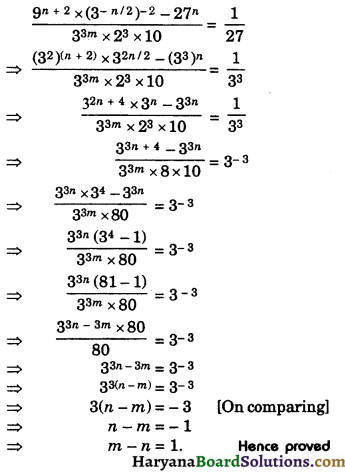
Question 18.
Prove that:
\(\frac{1}{1+x^{(b-a)}+x^{(c-a)}}+\frac{1}{1+x^{(a-b)}+x^{(c-b)}}\) + \(\frac{1}{1+x^{(b-c)}+x^{(a-c)}}\) = 1
Solution :

![]()
Question 19.
If ax = by = cz and b2 = ac, then prove that y = \(\frac{2 x z}{x+z}\).
Solution:
Let ax = by = cz = k
Then, a = k1/x, b = k1/y and c = k1/z
Now, b2 = ac, (given)
⇒ (k1/y)2 = k1/x × k1/z
⇒ k2/y = k1/x + 1/z
⇒ k2/y = k(z + x)/xz
⇒ \(\frac{2}{y}=\frac{z+x}{x z}\) [On Comparing]
⇒ \(\frac{1}{y}=\frac{x+z}{2 x z}\)
⇒ y = \(\frac{2 x z}{x+z}\). Hence proved.
Question 20.
Prove that:
\(\left(\frac{x^a}{x^b}\right)^{a^2+a b+b^2} \times\left(\frac{x^b}{x^c}\right)^{b^2+b c+c^2} \times\left(\frac{x^c}{x^a}\right)^{c^2+a b+a^2}\) = 1
Solution :
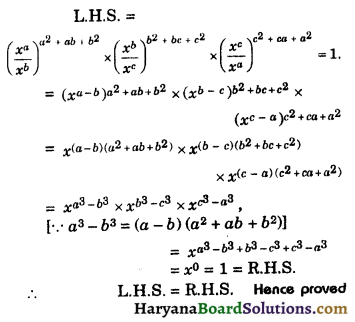
Question 21.
Simplify each of the following :
(i) [1 – {1 – (1 – n)-1}-1]-1
(ii) \(\frac{5^{n+3}-6 \times 5^{n+1}}{9 \times 5^n-5^n \times 2^2}\)
Solution :
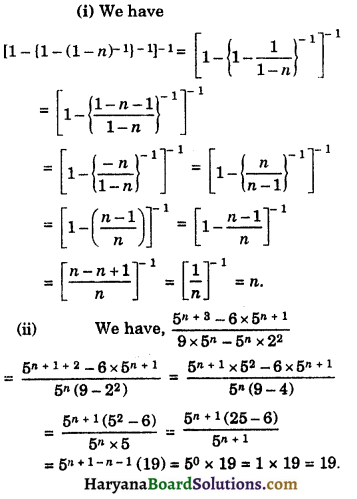
Question 22.
If \(\sqrt{57+12 \sqrt{15}}\) = a\(\sqrt{3}\) + b\(\sqrt{5}\), then find the values of a and b.
Solution :
We have,
\(\sqrt{57+12 \sqrt{15}}\) = a\(\sqrt{3}\) + b\(\sqrt{5}\)
⇒ \(\sqrt{12+45+12 \times \sqrt{3 \times 5}}\) = a\(\sqrt{3}\) + b\(\sqrt{5}\)
⇒ \(\sqrt{(2 \sqrt{3})^2+(3 \sqrt{5})^2+2 \times 2 \sqrt{3} \times 3 \sqrt{5}}\) = a\(\sqrt{3}\) + b\(\sqrt{5}\)
⇒ \(\sqrt{(2 \sqrt{3}+3 \sqrt{5})^2}\) = a\(\sqrt{3}\) + b\(\sqrt{5}\)
⇒ 2\(\sqrt{3}\) + 3\(\sqrt{5}\) = a\(\sqrt{3}\) + b\(\sqrt{5}\)
⇒ a = 2, b = 3
[Equating the rational and irrational parts]
Hence, a = 2, b = 3.
![]()
Question 23.
If x = 22/3 – 21/3 – 2, then prove that x3 + 6x2 + 18x + 18 = 0.
Solution :
We have
x = 22/3 – 21/3 – 2
⇒ x + 2 = 22/3 – 21/3
Cubing both sides, we get
(x + 2)3 = (22/3 – 21/3)3
⇒ x3 + 8 + 3 × x × 2(x + 2)
= (22/3)3 – (21/3)3 – 3 × 22/3 × 21/3 (22/3 – 21/3)
⇒ x3 + 8 + 6x(x + 2) = 22/3 × 3 – 21/3 × 3 – 3 × 22/3 + 1/3 (x + 2)
⇒ x3 + 8 + 6x2 + 12x = 22 – 21 – 3 × 2(x + 2)
⇒ x3 + 8 + 6x2 + 12x = 4 – 2 – 6x – 12
⇒ x3 + 6x2 + 12x + 8 = – 6x – 10
⇒ x3 + 6x2 + 18x + 18 = 0. Hence proved
Question 24.
Which of the variables P, Q, R and T given by the following equations, represent rational or irrational numbers:
(i) P2 = 25
(ii) Q2 = 0.16
(iii) R2 = 7
(iv) T2 = 0.4
(v) P3 = 125
(vi) R2 = 0.84.
Solution :
(i) We have,
P2 = 25
⇒ P = \(\sqrt{25}\) = 5
It is a rational number.
(ii) We have, Q2 = 0.16
⇒ Q = \(\sqrt{0.16}\) = 0.4
It is a rational number.
(iii) We have, R2 = 7
⇒ R = \(\sqrt{7}\) = 2.6457513…
It is an irrational number.
(iv) We have, T2 = 0.4
⇒ T = \(\sqrt{0.4}\) = 0.63245…
It is an irrational number.
(v) We have, P3 = 125
⇒ P = \(\sqrt[3]{125}\) = 5
It is a rational number.
(vi) We have, R2 = 0.84
⇒ R = \(\sqrt{0.84}\) = 0.916515…
It is an irrational number.
Long Answer Type Questions
Question 1.
Find three different irrational numbers between :
(i) \(\frac {1}{7}\) and \(\frac {4}{11}\)
(ii) \(\frac {3}{11}\) and \(\frac {5}{13}\)
(iii) 3 and 4.
(iv) \(\sqrt{2}\) and \(\sqrt{7}\).
Solution :
(i) \(\frac {1}{7}\) = 0.142857142857…
\(\frac {4}{11}\) = 0.3636363636…
Three different irrational numbers are 0.17010010001….0.262020020002… and 0.3010020040002…
(ii) \(\frac {3}{11}\) = 0.2727272727…
\(\frac {5}{13}\) = 0.384615384…
Three different irrational numbers are 0.28030100131004…, 0.3011001110023001… and 0.32032003200032…
(iii) Three different irrational numbers between 3 and 4 are 3.15013001500014000016…, 3.202002000204… and 3.35035003500035…
(iv) Consider the squares of \(\sqrt{2}\) and \(\sqrt{7}\).
(\(\sqrt{2}\))2 = 2 and (\(\sqrt{7}\))2 = 7
Choose any three numbers say 3, 5, 6 which lie between 2 and 7.
Since, these numbers lie between 2 and 7, therefore the numbers \(\sqrt{3}\), \(\sqrt{5}\) and \(\sqrt{6}\) lie between \(\sqrt{2}\) and \(\sqrt{7}\). Hence, three irrational numbers between \(\sqrt{2}\) and \(\sqrt{7}\) are \(\sqrt{3}\), \(\sqrt{5}\) and \(\sqrt{6}\).
![]()
Question 2.
Simplify each of the following by rationalising the denominators:
(i) \(\frac{1}{2-\sqrt{3}}+\frac{5}{3-\sqrt{2}}-\frac{1}{\sqrt{3}+\sqrt{2}}\)
(ii) \(\frac{4 \sqrt{3}}{2-\sqrt{2}}-\frac{30}{4 \sqrt{3}-3 \sqrt{2}}-\frac{3 \sqrt{2}}{3+2 \sqrt{3}}\)
Solution :
(i) We have
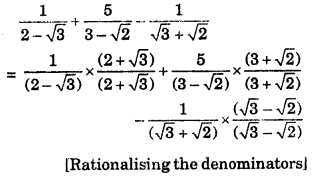
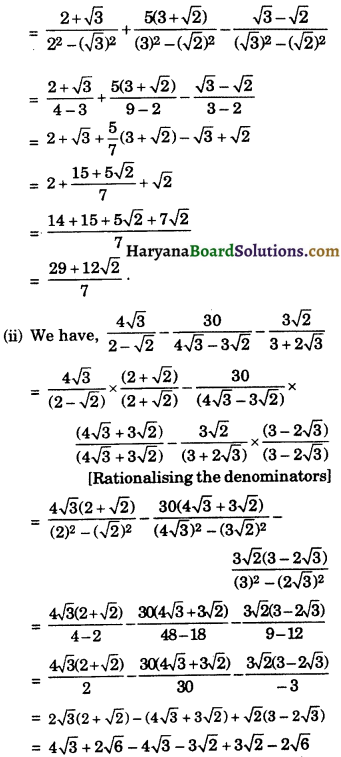
= 0.
Question 3.
If both a and b are rational numbers, then find the values of a and b in each of the following equations:
(i) \(\frac{\sqrt{5}+\sqrt{3}}{\sqrt{5}-\sqrt{3}}\) = a – b\(\sqrt{15}\)
(ii) \(\frac{\sqrt{2}+\sqrt{3}}{3 \sqrt{2}-2 \sqrt{3}}\) = a + b\(\sqrt{6}\)
(iii) \(\frac{7+\sqrt{5}}{7-\sqrt{5}}-\frac{7-\sqrt{5}}{7+\sqrt{5}}\) = a + \(\frac {7}{11}\)\(\sqrt{5}\)b
Solution:

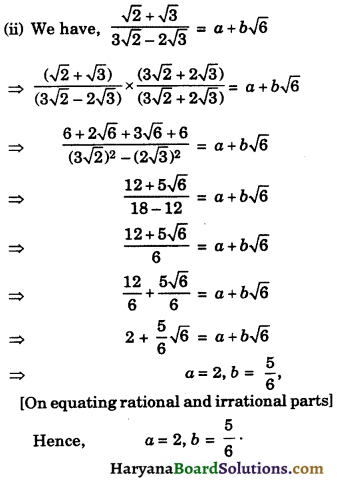
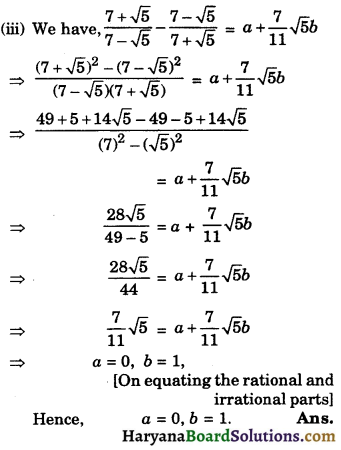
![]()
Question 4.
If x = \(\frac{\sqrt{2}-1}{\sqrt{2}+1}\) and \(\frac{\sqrt{2}+1}{\sqrt{2}-1}\), then find x2 + y2 .
Solution :
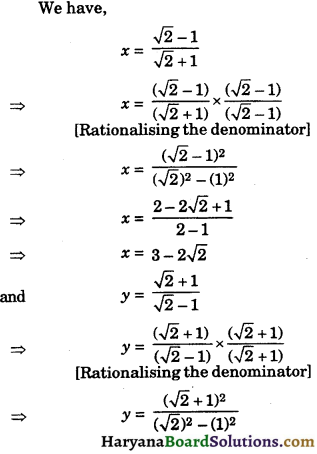
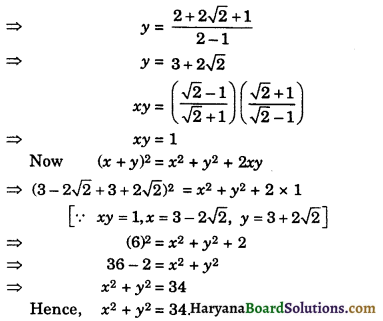
Question 5.
If a = \(\frac{\sqrt{3}+\sqrt{2}}{\sqrt{3}-\sqrt{2}}\) and b = \(\frac{\sqrt{3}-\sqrt{2}}{\sqrt{3}+\sqrt{2}}\), then find a3 + b3.
Solution :
We have,
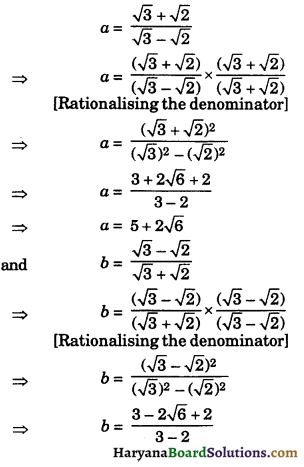
⇒ b = 5 – 2\(\sqrt{6}\)
a + b = 5 + 2\(\sqrt{6}\) + 5 – 2\(\sqrt{6}\)
⇒ a + b = 10
ab = \(\left(\frac{\sqrt{3}+\sqrt{2}}{\sqrt{3}-\sqrt{2}}\right) \times\left(\frac{\sqrt{3}-\sqrt{2}}{\sqrt{3}+\sqrt{2}}\right)\)
⇒ ab = 1
Now, a3 + b3 = (a + b)3 – 3ab(a + b)
⇒ a3 + b3 = (10)3 – 3 × 1 × (10)
[∵ a + b = 10 and ab = 1]
⇒ a3 + b3 = 1000 – 30
⇒ a3 + b3 = 970
Hence, a3 + b3 = 970
Question 6.
If a = \(\frac{1}{2-\sqrt{3}}\) and b = \(\frac{1}{2+\sqrt{3}}\), then find a2 + ab + b2
Solution :
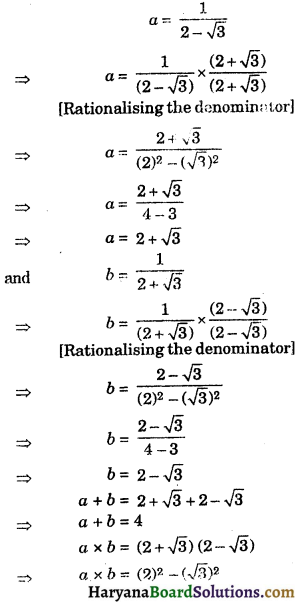
⇒ a × b = 4 – 3
⇒ ab = 1
Now, a2 + ab + b2 = a2 + 2ab + b2 – ab
[Adding and subtracting ab]
⇒ a2 + ab + b2 = (a + b)2 – ab
⇒ a2 + ab + b2 = (4)2 – 1
[∵ a + b = 4, ab = 1]
⇒ a2 + ab + b2 = 16 – 1
Hence, a2 + ab + b2 = 15
Question 7.
If x = \(\frac{1}{\sqrt{5}-2}\), then find the values of :
(i) x2 + \(\frac{1}{x^2}\)
(ii) x2 – \(\frac{1}{x^2}\)
Solution :
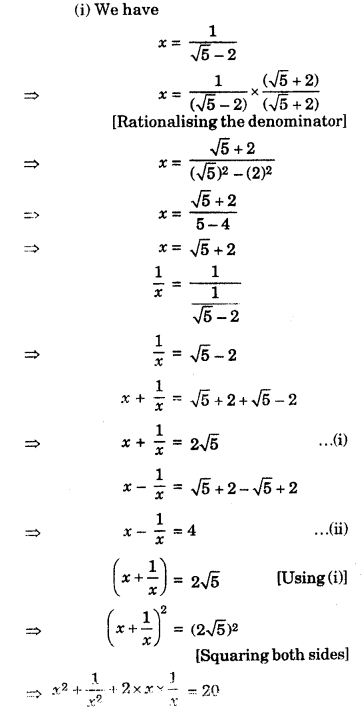

![]()
Question 8.
If x = \(\frac{5-\sqrt{21}}{2}\), then prove that \(\left(x^3+\frac{1}{x^3}\right)-5\left(x^2+\frac{1}{x^2}\right)+\left(x+\frac{1}{x}\right)\) = 0
Solution :

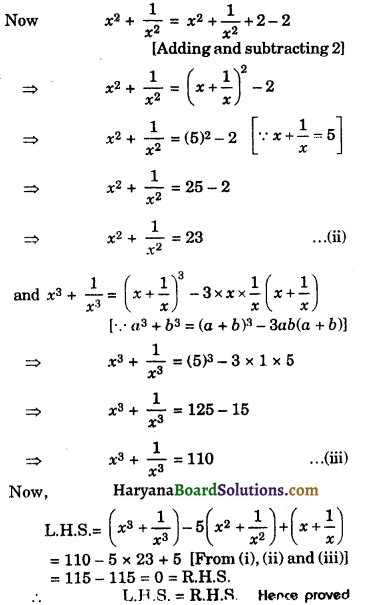
Question 9.
If x = \(\sqrt{3+2 \sqrt{2}}\), then find the value of x + \(\frac {1}{x}\) and x2 + \(\frac{1}{x^2}\).
Solution :
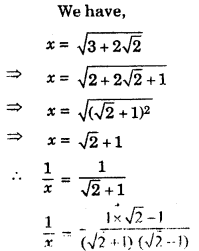
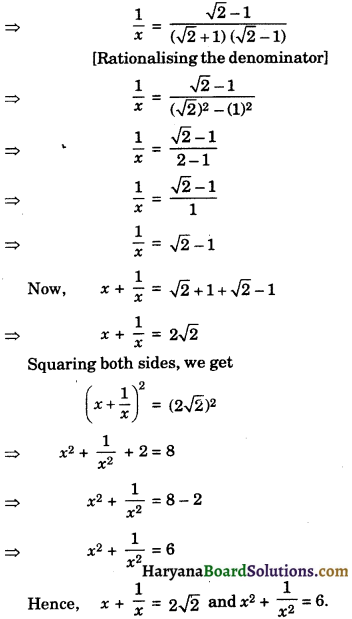
![]()
Question 10.
If x = \(\frac{1}{\sqrt{3}-\sqrt{2}}\), prove that x3 + \(\frac{1}{x^3}\) + 2(x2 + \(\frac{1}{x^2}\)) – 9(x + \(\frac {1}{x}\)) = 20
Solution :
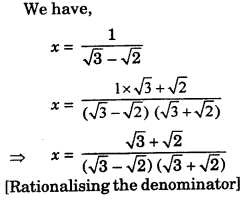
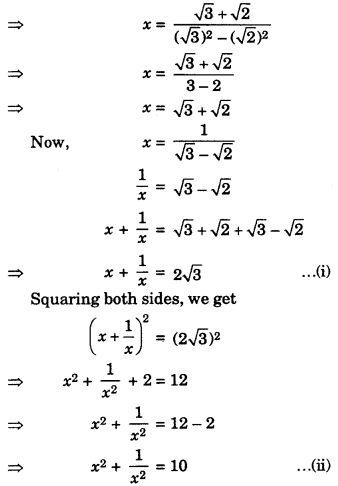
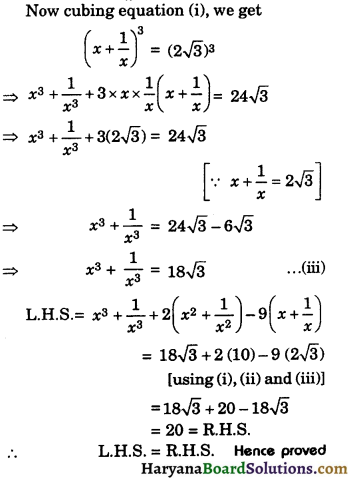
Question 11.
If x = \(\frac{\sqrt{a+2 b}+\sqrt{a-2 b}}{\sqrt{a+2 b}-\sqrt{a-2 b}}\), then prove that b2x2 – abx + b2 = 0.
Solution :
We have,

Question 12.
If x = \(\frac{\sqrt{3}}{2}\), then show that \(\frac{1+x}{1+\sqrt{1+x}}+\frac{1-x}{1-\sqrt{1-x}}\) = 1
Solution :
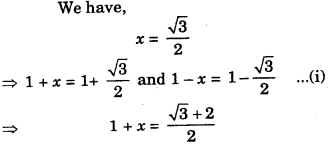
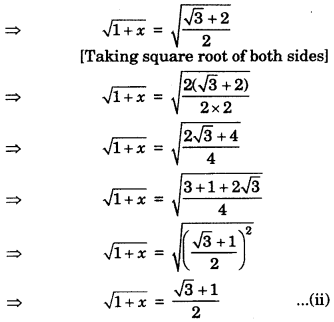
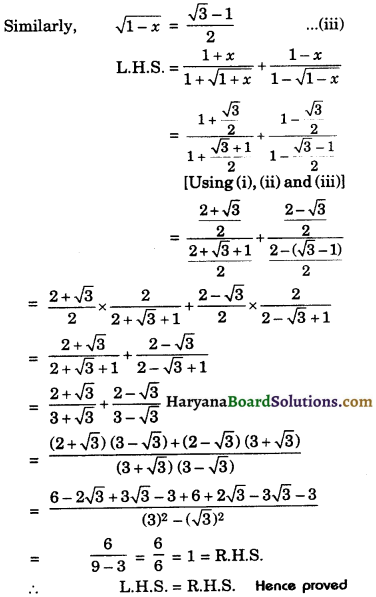
![]()
Question 13.
If \(\sqrt{2}\) = 1.4142 , \(\sqrt{3}\) = 1.7320 and \(\sqrt{6}\) = 2.4495, find correct to three places of decimal, the value of:
(i) \(\sqrt{5+2 \sqrt{6}}+\sqrt{5-2 \sqrt{6}}\)
(ii) \(\frac{1}{\sqrt{3}-\sqrt{2}-1}\)
Solution :
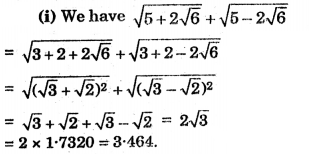
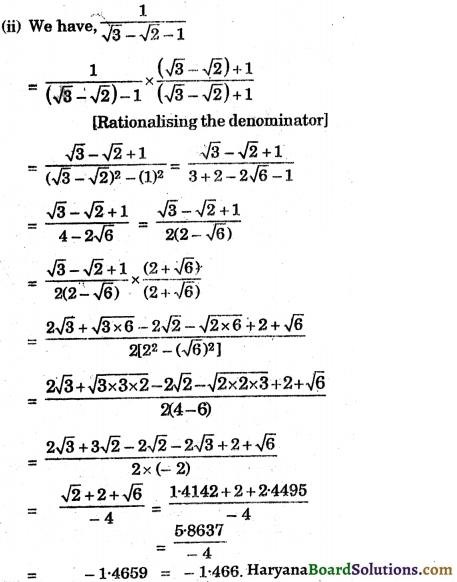
Question 14.
Express the following with rational denominator \(\frac{1}{\sqrt{10}+\sqrt{14}+\sqrt{15}+\sqrt{21}}\).
Solution :
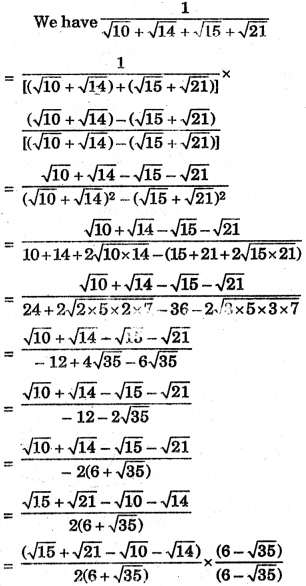
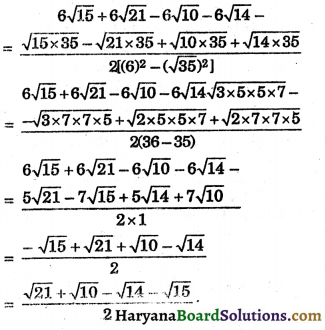
Multiple Choice Questions :
Choose the correct alternative each of the following :
Question 1.
Every rational number is : [NCERT Exemplar Problems]
(a) a natural number
(b) an integer
(c) a real number
(d) a whole number
Solution :
(c) a real number
![]()
Question 2.
Between any two rational numbers there:
[NCEAT Exemplar Problems]
(a) is no rational number
(b) is exactly one rational number
(c) are infinitely many rational numbers
(d) there are only rational numbers and no irrational numbers
Solution :
(c) are infinitely many rational numbers
Question 3.
Quotient of any two irrational numbers is :
(a) always an irrational number
(b) always a rational number
(c) always an integer
(d) some times rational number, some times irrational number
Solution :
(d) some times rational number, some times irrational number
Question 4.
Product of any two irrational numbers is : [NCERT Exemplar Problems]
(a) always an irrational number
(b) may be rational or irrational number
(c) always an integer
(d) always a rational number
Solution :
(b) may be rational or irrational number
Question 5.
Decimal representation of rational number cannot be : [NCERT Exemplar Problems]
(a) non-terminating but recurring
(b) terminating
(c) non-terminating non-recurring
(d) non-terminating
Solution :
(c) non-terminating non-recurring
Question 6.
Which of the following is rational :
(a) 0.3010010010001….
(b) π
(c) \(\sqrt{2}\)
(d) \(0 . \overline{142857}\)
Solution :
(d) \(0 . \overline{142857}\)
![]()
Question 7.
Which of the following is an irrational :
(a) 0.090909……..
(b) 0.25
(c) \(\frac {22}{7}\)
(d) \(\sqrt{0.4}\)
Solution :
(d) \(\sqrt{0.4}\)
Question 8.
A rational number between \(\sqrt{2}\) and \(\sqrt{3}\) is : [NCERT Exemplar Problems]
(a) \(\frac{\sqrt{2}+\sqrt{3}}{2}\)
(b) \(\frac{\sqrt{2} \times \sqrt{3}}{2}\)
(c) 1.5
(d) 1.8
Solution :
(c) 1.5
Question 9.
An irrational number between \(\sqrt{2}\) and \(\sqrt{3}\) is :
(a) 51/4
(b) \(\sqrt{2}\) + \(\sqrt{3}\)
(c) \(\frac{\sqrt{2}+\sqrt{3}}{2}\)
(d) \(\sqrt{\sqrt{2}} \times \sqrt{3}\).
Solution :
(d) \(\sqrt{\sqrt{2}} \times \sqrt{3}\).
Question 10.
\(\sqrt[4]{(81)^{-2}}\) is equal to : [NCERT Exemplar Problems]
(a) \(\frac {1}{9}\)
(b) 9
(c) \(\frac {1}{3}\)
(d) \(\frac {1}{81}\)
Solution :
(a) \(\frac {1}{9}\)
Question 11.
If , then x = \(\frac{1}{2+\sqrt{3}}\), is equal to :
(a) 2\(\sqrt{3}\)
(b) 4
(c) – 2\(\sqrt{3}\)
(d) 4 – 2\(\sqrt{3}\)
Solution :
(b) 4
![]()
Question 12.
The value of 1.999 in the form \(\frac {p}{q}\), where p and q are integers and q ≠ 0, is : [NCERT Exemplar Problems]
(a) \(\frac {19}{10}\)
(b) \(\frac {1999}{1000}\)
(c) 2
(d) \(\frac {1}{9}\)
Solution :
(c) 2